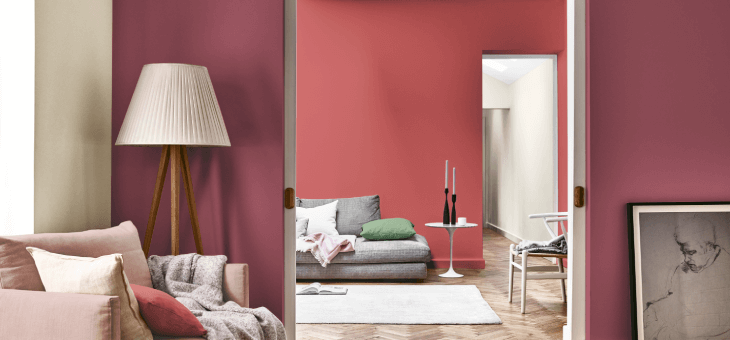The colours on our walls at home affect how we feel much more than we realise, according to Marianne Shillingford, creative director at Dulux.
Whether you need a mood lift, a creative space to think or calming place to chill out, throwing some colour on the walls can make all the difference, she says.
“We fill our wardrobe with colours that help us to become something when we need to. We use colour if we’re going out for a wedding or a big celebration, we’ll put on more colour than we normally would if we went into the office,” Ms Shillingford says.
“So we use colour all the time as a language to express the way we feel, or how we want to feel. And in our homes, it is more important than anything to get it right.”

And spending more time at home during the past two years means many of us want to make changes to reinvigorate the space we’ve become overly familiar with. “Adding little pops of colour – rather than completely redecorating – is something that’s achievable and changeable without being overwhelming,” she adds.
Read: Tips for painting interior woodwork
This is what Ms Shillingford suggests you should do to evoke different moods using paint.
To create a stimulating environment
“Red is the colour that has the longest visual wavelength – it draws your attention. Red has long been associated with eating rooms, restaurants and dining rooms, because it’s the most stimulating colour. It stimulates conversation, it stimulates our taste buds, it makes everything taste better and sweeter. It’s an incredibly convivial colour for an eating space,” says Ms Shillingford, who recommends Fitzrovia Red or Pugin Red from the Dulux Heritage range.
“You’d be amazed how a tiny flash of red can create a little pocket of energy and excitement … Red is hugely powerful, but it’s one of those colours that … [overwhelm] quite quickly if you use too much of it.”
To evoke calmness
“Creating calm in any space is about shorter wavelength colours – like blues and greens, that reconnect us with nature,” says Ms Shillingford.

“They appear slightly further away from us, so when we paint them on the walls, it makes the space feel less enclosed and more connected with the outdoors. It’s a fact that being in nature can help soothe a troubled soul, so the colours of nature – whether they are soft, organic blues, grass greens or the colours of raw organic materials – they’re not overwhelming, which I think is perfect if you’ve got children and you’re trying to juggle work and family life.”
Read: Dulux colour of the year 2022 is cool, calming and hopeful
For a happy place to be
“We associate happiness with colours that have more intensity and pigment to them. It’s like putting a little bit of lipstick on, a piece of jewellery, or some amazing shoes. We use flashes of colour like flashes of joy – and it’s the same in a home.
“We often think the most joyful colour is yellow, because it reminds us of the sunshine, the first flowers of spring, yellow daffodils, buttercups, primroses. It also reminds us of hopeful things that happen in spring, like harvest corn. It’s uplifting, and it’s quite a common colour for nurseries.

“Pink is another one. We’ve reclaimed pink from its associations with little girls and Barbie – we can all enjoy pink, it’s a gentle flash of joy.”
To evoke feelings of sleepiness
“Dark blues and deep greens are perfect for helping you sleep,” says Ms Shillingford.
“Some people do the whole wrap of a room and I think it can look lovely, but I get the feeling people are starting to paint out [sections of a room]. You could split your bedroom into two different spaces, say if you painted up the wall onto the ceiling and down the other side, to create a sort of canopy around your bed in a slighter deeper colour.”
This could “help you relax”, she suggests, “Then you could have a more energising colour somewhere else in the room, that helps you get up in the morning.”
View this post on Instagram
Read: How to get the colourful cottage look
To inspire motivation or creativity
“Get the energy levels up using a strong colour, but if you use too much of a strong colour you can become slightly agitated,” says Ms Shillingford.
“So use blocks of colour, like colour blocking around a picture, colour blocking around a sofa, or a big shape [above a sofa]. Orange is the most creative colour, it’s got the vibrancy of red, but not the scariness of it, so it’s got that energy. More creative people tend to be more relaxed with intense colours, so [go for] oranges and yellows.”
How colourful is your house? Do you prefer bright colours or more natural ones on your walls? Let us know in the comments section below.
– With PA
If you enjoy our content, don’t keep it to yourself. Share our free eNews with your friends and encourage them to sign up.

